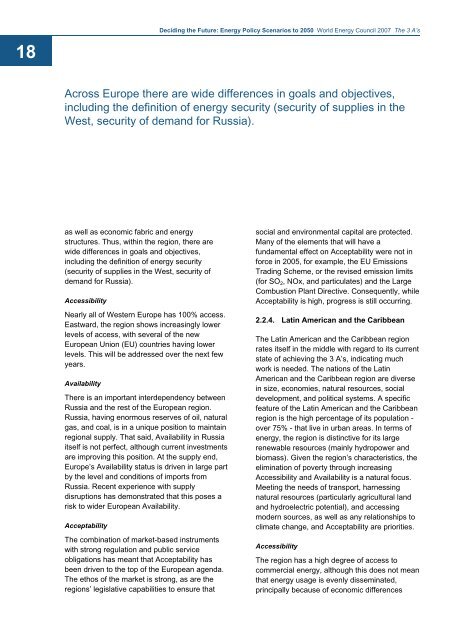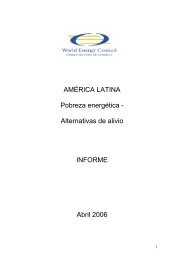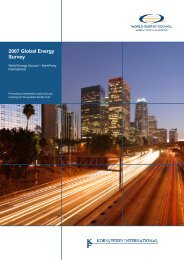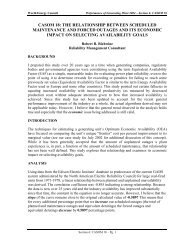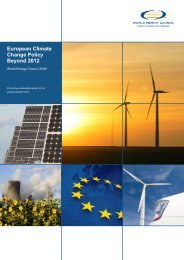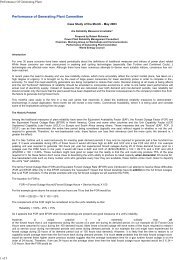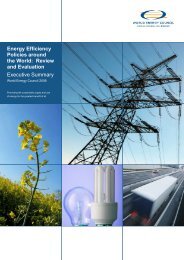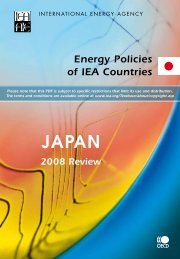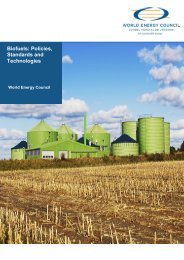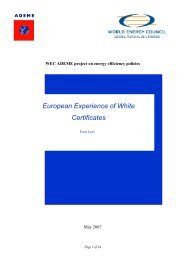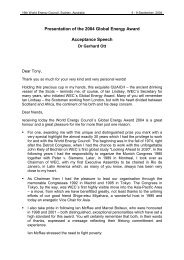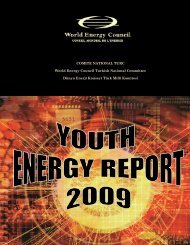Deciding the Future: Energy Policy Scenarios to 2050
Deciding the Future: Energy Policy Scenarios to 2050
Deciding the Future: Energy Policy Scenarios to 2050
Create successful ePaper yourself
Turn your PDF publications into a flip-book with our unique Google optimized e-Paper software.
18<br />
<strong>Deciding</strong> <strong>the</strong> <strong>Future</strong>: <strong>Energy</strong> <strong>Policy</strong> <strong>Scenarios</strong> <strong>to</strong> <strong>2050</strong> World <strong>Energy</strong> Council 2007 The 3 A’s<br />
Across Europe <strong>the</strong>re are wide differences in goals and objectives,<br />
including <strong>the</strong> definition of energy security (security of supplies in <strong>the</strong><br />
West, security of demand for Russia).<br />
as well as economic fabric and energy<br />
structures. Thus, within <strong>the</strong> region, <strong>the</strong>re are<br />
wide differences in goals and objectives,<br />
including <strong>the</strong> definition of energy security<br />
(security of supplies in <strong>the</strong> West, security of<br />
demand for Russia).<br />
Accessibility<br />
Nearly all of Western Europe has 100% access.<br />
Eastward, <strong>the</strong> region shows increasingly lower<br />
levels of access, with several of <strong>the</strong> new<br />
European Union (EU) countries having lower<br />
levels. This will be addressed over <strong>the</strong> next few<br />
years.<br />
Availability<br />
There is an important interdependency between<br />
Russia and <strong>the</strong> rest of <strong>the</strong> European region.<br />
Russia, having enormous reserves of oil, natural<br />
gas, and coal, is in a unique position <strong>to</strong> maintain<br />
regional supply. That said, Availability in Russia<br />
itself is not perfect, although current investments<br />
are improving this position. At <strong>the</strong> supply end,<br />
Europe’s Availability status is driven in large part<br />
by <strong>the</strong> level and conditions of imports from<br />
Russia. Recent experience with supply<br />
disruptions has demonstrated that this poses a<br />
risk <strong>to</strong> wider European Availability.<br />
Acceptability<br />
The combination of market-based instruments<br />
with strong regulation and public service<br />
obligations has meant that Acceptability has<br />
been driven <strong>to</strong> <strong>the</strong> <strong>to</strong>p of <strong>the</strong> European agenda.<br />
The ethos of <strong>the</strong> market is strong, as are <strong>the</strong><br />
regions’ legislative capabilities <strong>to</strong> ensure that<br />
social and environmental capital are protected.<br />
Many of <strong>the</strong> elements that will have a<br />
fundamental effect on Acceptability were not in<br />
force in 2005, for example, <strong>the</strong> EU Emissions<br />
Trading Scheme, or <strong>the</strong> revised emission limits<br />
(for SO 2 , NOx, and particulates) and <strong>the</strong> Large<br />
Combustion Plant Directive. Consequently, while<br />
Acceptability is high, progress is still occurring.<br />
2.2.4. Latin American and <strong>the</strong> Caribbean<br />
The Latin American and <strong>the</strong> Caribbean region<br />
rates itself in <strong>the</strong> middle with regard <strong>to</strong> its current<br />
state of achieving <strong>the</strong> 3 A’s, indicating much<br />
work is needed. The nations of <strong>the</strong> Latin<br />
American and <strong>the</strong> Caribbean region are diverse<br />
in size, economies, natural resources, social<br />
development, and political systems. A specific<br />
feature of <strong>the</strong> Latin American and <strong>the</strong> Caribbean<br />
region is <strong>the</strong> high percentage of its population -<br />
over 75% - that live in urban areas. In terms of<br />
energy, <strong>the</strong> region is distinctive for its large<br />
renewable resources (mainly hydropower and<br />
biomass). Given <strong>the</strong> region’s characteristics, <strong>the</strong><br />
elimination of poverty through increasing<br />
Accessibility and Availability is a natural focus.<br />
Meeting <strong>the</strong> needs of transport, harnessing<br />
natural resources (particularly agricultural land<br />
and hydroelectric potential), and accessing<br />
modern sources, as well as any relationships <strong>to</strong><br />
climate change, and Acceptability are priorities.<br />
Accessibility<br />
The region has a high degree of access <strong>to</strong><br />
commercial energy, although this does not mean<br />
that energy usage is evenly disseminated,<br />
principally because of economic differences


